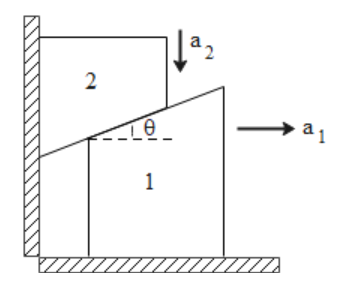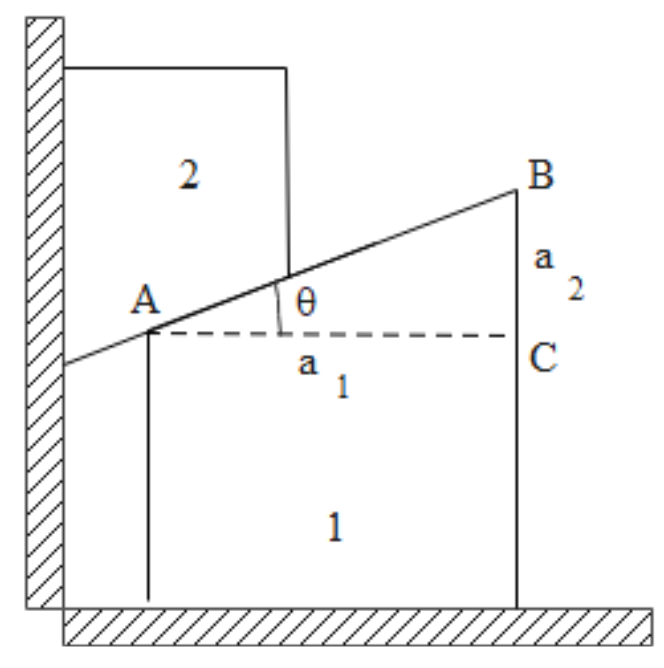
In the arrangement shown, the relation between the acceleration of wedge 1 and wedge 2 is

$\begin{align}
& {\text{A}}{\text{. }}{a_1} = {a_2}\sin \theta \\
& {\text{B}}{\text{. }}{a_1} = {a_2}\cos \theta \\
& {\text{C}}{\text{. }}{a_1} = {a_2}\cot \theta \\
& {\text{D}}{\text{. }}{a_1} = {a_2}\tan \theta {\text{ }} \\
\end{align} $

Answer
466.2k+ views
Hint: In the diagram, we are given the directions of two accelerations and also the angle between the two wedges. Based on the given directions and by using the simple trigonometric relations for sides of the triangle formed by the two accelerations, we shall be able to get the required answer.
Complete step-by-step solution
Consider the given arrangement of two wedges. We are given the directions of two accelerations and also the angle between the two wedges which is equal to $\theta $.

Based on the directions of the two accelerations, we can get a triangle ABC, in which AC is equal to ${a_1}$ while BC is equal to ${a_2}$.
As we know that in a right angled triangle, the ratio of the perpendicular and the base is equal to the tangent of the angle at the base of the triangle. In the same way, in the triangle ABC, we can write the following expression for the two accelerations.
$\dfrac{{BC}}{{AC}} = \tan \theta $
Inserting the known values of sides, we get
$\begin{align}
&\Rightarrow \dfrac{{{a_2}}}{{{a_1}}} = \tan \theta \\
&\Rightarrow {a_2} = {a_1}\tan \theta \\&{\text{or }}{a_1} = {a_2}\cot \theta \\
\end{align} $
This is the required relation between the acceleration of wedge 1 and the acceleration of wedge 2. Therefore, the correct answer is option C.
Note: 1. The two accelerations are vector quantities and their directions have allowed us to construct a triangle from which we could get a relation between them.
2. The obtained expression shows that the two accelerations of the two wedges inclined at an angle to each other are related to each other through the tangent or cotangent of the angle between them. This relation is obtained because the two directions are perpendicular to each other.
Complete step-by-step solution
Consider the given arrangement of two wedges. We are given the directions of two accelerations and also the angle between the two wedges which is equal to $\theta $.

Based on the directions of the two accelerations, we can get a triangle ABC, in which AC is equal to ${a_1}$ while BC is equal to ${a_2}$.
As we know that in a right angled triangle, the ratio of the perpendicular and the base is equal to the tangent of the angle at the base of the triangle. In the same way, in the triangle ABC, we can write the following expression for the two accelerations.
$\dfrac{{BC}}{{AC}} = \tan \theta $
Inserting the known values of sides, we get
$\begin{align}
&\Rightarrow \dfrac{{{a_2}}}{{{a_1}}} = \tan \theta \\
&\Rightarrow {a_2} = {a_1}\tan \theta \\&{\text{or }}{a_1} = {a_2}\cot \theta \\
\end{align} $
This is the required relation between the acceleration of wedge 1 and the acceleration of wedge 2. Therefore, the correct answer is option C.
Note: 1. The two accelerations are vector quantities and their directions have allowed us to construct a triangle from which we could get a relation between them.
2. The obtained expression shows that the two accelerations of the two wedges inclined at an angle to each other are related to each other through the tangent or cotangent of the angle between them. This relation is obtained because the two directions are perpendicular to each other.
Recently Updated Pages
Master Class 11 English: Engaging Questions & Answers for Success

Master Class 11 Computer Science: Engaging Questions & Answers for Success

Master Class 11 Maths: Engaging Questions & Answers for Success

Master Class 11 Social Science: Engaging Questions & Answers for Success

Master Class 11 Economics: Engaging Questions & Answers for Success

Master Class 11 Business Studies: Engaging Questions & Answers for Success

Trending doubts
One Metric ton is equal to kg A 10000 B 1000 C 100 class 11 physics CBSE

The sequence of spore production in Puccinia wheat class 11 biology CBSE

Petromyzon belongs to class A Osteichthyes B Chondrichthyes class 11 biology CBSE

Comparative account of the alimentary canal and digestive class 11 biology CBSE

Lassaignes test for the detection of nitrogen will class 11 chemistry CBSE

The type of inflorescence in Tulsi a Cyanthium b Hypanthodium class 11 biology CBSE




